 Romanian universities (and the Academy) produced about 67,000 Ph.D.s in science disciplines from 1990 until now.
Romanian universities (and the Academy) produced about 67,000 Ph.D.s in science disciplines from 1990 until now.
The number itself is not large – we have 3.34 holders of such titles per 1,000 inhabitants, which places us below the European average.
The problem is that half of all doctorates were obtained in the last 5 years (30,000 after 2010), which raises many suspicions regarding their quality, besides the proportions of plagiarisms, probably unique in the world:
after a peak in 2012 (over 6,000 Ph.D.s graduated that year) the number dropped sharply over 3 times this year, when doctoral students get scared of the plagiarism scandals. Along with their number, allocations for universities have also decreased.
Brief history of doctoral flares
In 1990, Romania had under 2,000 holders of a Ph.D. in science and in 1990 there were granted 17 such diplomas.
The system has been rapidly developing and in 1999 exceeded 1,000 titles awarded.
The second bar was removed in 2005, when Romania adopted the Bologna process (in 2005), according to which the doctorate is not a form of scientific recognition anymore, but one of the three cycles of university studies:
- Bachelor’s studies
- Master’s studies
- Doctoral studies
This is how the number increased from an annual average of 1,000 new Ph.D.s until 2008 (when the first graduates completed Bologna doctoral studies) to an annual record production of 5,000 new holders of such titles, after this year.
The record was reached in the same year when Nature magazine publishes the first accusation of plagiarism against former premier Victor Ponta:
*
- Evolution of the Ph.D. titles granted
- Data source: Ministry of Education
*
2012 – peak in doctorates production in the year when Victor Ponta was accused of plagiarism
The number of doctorates awarded in recent years is relative to population and the situation in other member states: Romania awarded last year 1.4 titles per 1,000 inhabitants aged between 25 and 34, as compared to Slovenia – 3.5, Denmark – 3.2 titles, Portugal – 3.1, Finland, Sweden and the UK – 2.9 each, and Germany – 2.8.
*
- Number of Ph.D. titles (per 1,000 inhabitants aged between 25 and 34)
- Data source: Eurostat
*
Given that only four Romanian universities were included in the QS World University Rankings 2016-2017, all of which ranked 701+, is difficult to accept that 49 universities in Romania successfully produce Ph.D. theses that could become reference works internationally.
3 times more Ph.D.s than scientific articles published
If we would compare the new titles to other indicators – investments in this area (we are the European country with the lowest budgets granted to higher education and research), GDP or outputs (top scientific articles in journals from the field, patents etc.) it becomes clear that we have an „overproduction” of such titles.
This is the conclusion of a study conducted in 2014 by Dr. Alexandru Dan Corlan, doctor who examined the correlation between the number of Ph.D. holders and SCI articles (Science Citation Index articles), one of the research quality indicators.
Dan Corlan found there is only one article published this category per three Ph.D. titles, which is a low level even in comparison with Bulgaria, where for each Ph.D. title in 2010 there was a corresponded SCI work:
The conclusion of Dan Corlan’s analysis was that the excess of doctorate is found in several areas with significant disproportion to SCI articles, mainly agricultural sciences, where Romania ranks first in the world.
 „The research notes that in some areas the proportion of doctorates to articles is excessively high.
„The research notes that in some areas the proportion of doctorates to articles is excessively high.
In the natural sciences field, though, we have too few Ph.Ds. as compared to the number of articles written,” said Dan Corlan (photo) for cursdeguvernare.ro.
The harvest of Ph.D.s by fields
In 2010, there were 18 Ph.D.s awarded in agricultural sciences per 1 million inhabitants, four times more than in Germany (4.93) and in terms of SCI articles, we have 32.5 doctorates per SCI article, unlike France (one Ph.D. per 50 articles published), for example.
Despite the large number of Ph.D.s, research in this field “is dying”, according to recent analysis of the Ministry of Agriculture and the Academy, and reform is needed. Among other things, this is the field with the highest average age of researchers.
An unbalanced situation is also registered for the humanities.
As for natural sciences, the ratio of Ph.D.s to the number of articles was 1:10, similar to the most advanced research systems.
The situation has maintained in the latest research and innovation scoreboard (2016), for the indicator presenting the articles published by Romanian scientists in top 10% most cited publications:
Source: Eurostat
From the evolution’s perspective, there was even a decrease last year as compared to 2014 of the number of such articles published in the top 10% publications:
The disproportion between the number of doctoral graduates and outputs can be observed in the gap between research and development targets set for 2020 and the actual situation in which we find ourselves: only one indicator was close to the target – the number of doctoral graduates:
*
- Last value Target (2017) Target (2020)
- Assumptions
- Pubic spending on research and development, as share of GDP
- Number of Ph.D. graduates (ISCED 6) per 1,000 inhabitants aged between 25-34
- Number of researchers in the public sector (full time equivalent)
- Scientific publications in top 10% of the world most quoted publications, as % of the total scientific publications at national level
- International co-authored scientific publications per 1 million inhabitants
- Risk capital, as share of GDP
- Involving the private sector
- Spending on research and development of the business sector, as share of GDP
- Number of researchers in the private sector (full time equivalent)
- Public-private co-authored publishing per 1 million inhabitants
- Innovative SMEs that collaborate with others (%)
- Patent applications EPO/year
- Patent applications USTPO/year
- Community trademark applications/ EUR 1 billion adjusted GDP to the purchasing power parity
*
Business to business: Thousands of doctoral students withdrew after the plagiarisms scandal, universities lose clients and money
There were 1,559 Ph.D.s titles issued until 15 October 2016 and Sorin Cîmpeanu estimates that the number will not reach 2,000 titles for the whole year.
The reasons:
- The plagiarisms scandal
- Tightening of procedures (it lasts one year from the work completion until the presentation)
- The ending of the EU financed projects for doctoral programs
After the outbreak in 2012 of the plagiarisms scandal (at the moment of Nature magazine’s accusation to former Prime Minister Victor Ponta), both universities and doctorates became more reluctant.
 Public pressure led to a more careful filtering of these works, several times along the way, in order to detect any similarities to other theses, explained professor Sorin Cîmpeanu, former Minister of Education, to cursdeguvernare.ro.
Public pressure led to a more careful filtering of these works, several times along the way, in order to detect any similarities to other theses, explained professor Sorin Cîmpeanu, former Minister of Education, to cursdeguvernare.ro.
„Personally, I use three anti-plagiarism software programs, acquired by the university or used for free by the Ministry of Education,” said Sorin Cîmpeanu.
As a result, the number of titles issued decreased from about 6,258 in 2012 to under 2,000 in 2016.
Three xxxx ago, 4,619 doctoral students have been registered, which means that over 43% were lost along the way – namely, they gave up. The actual share is even higher, explains Sorin Cîmpeanu, as universities do not report all dropouts:
„Category of those who renounce de facto, but not de jure, is higher. They enroll in the first year and realize it is not for them – it is too hard, requires too much effort and other reasons – and the university, while knowing that the person dropped out, asks to her to be understanding and not submit the waiver documents, in order to still keep her and get funding for two more years, „said the former minister.
*
- Grants for doctoral students enrolled starting in 2011-2012 (annual grant background for doctorate)
- Categories of spending Field of financing
- Salary of the thesis advisor Costs of the advanced studies program
- Salary of the members of the advisor commission
- Specializing program based on advanced studies
- Additional specializing program
- Funding for research Costs for the research program
- Administrative costs of the doctoral school
- Total grant (scholarship excluded)
*
Legend:
- D1 (programs in the socio-economic and humanities ranking fields)
- D2 (for ranking areas of engineering sciences, exact sciences and biological sciences)
- D3 (medical sciences, architecture and urbanism) and D4 (performing arts, music, etc.).
The plagiarisms scandal had an immediate impact: after a steady growth for 8 years, the number of doctoral students enrolled in the first year of study fell below 4,000 in 2012 (data from the graph are for date 1 January of each year, which means that 2013 corresponds to the academic year 2012 – 2013):
Data source: CNFIS


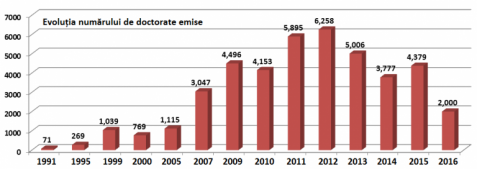

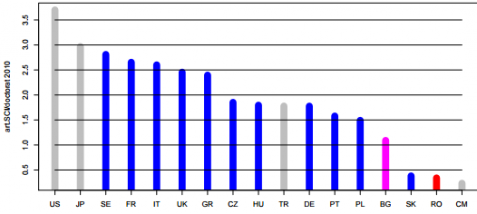
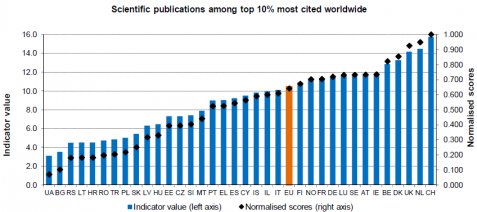
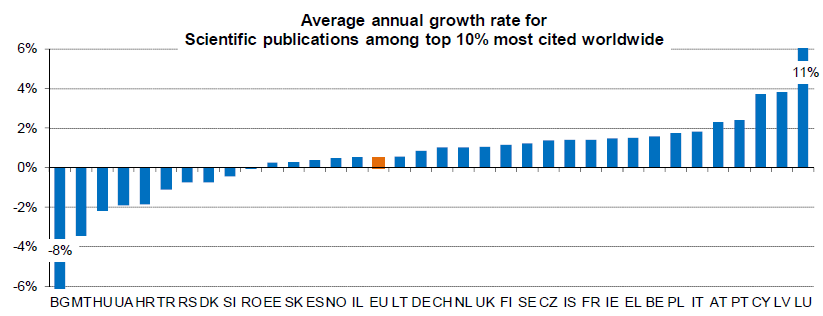
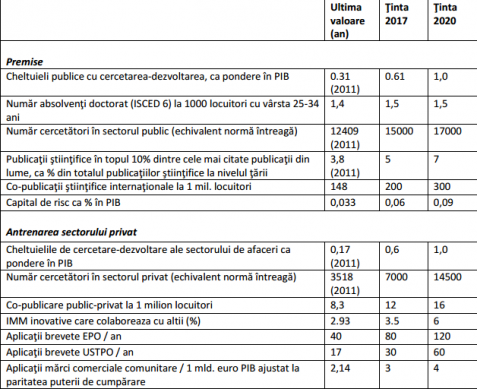










Un răspuns
Fluctuatia numarului de doctorate nu are legatura cu scandalul plagiatelor ci cu bursele europene si cuantumul lor.faceti un studiu asupra acestei corelatii si veti fi surprinsi.